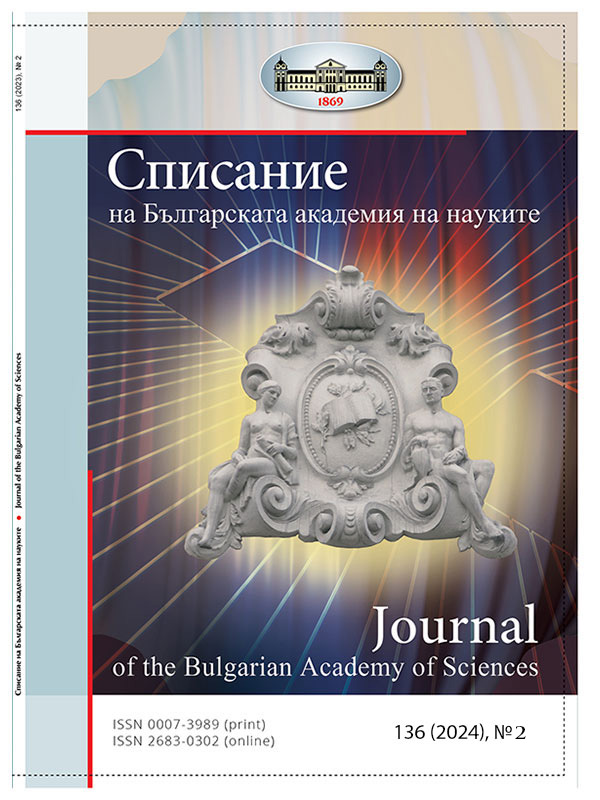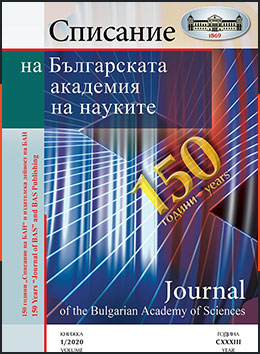Journal View
Journal of the Bulgarian Academy of Sciences
- Year: 2024
- Number: 2
- Language: Български, English
- Download Issue

-
Genome Editing – RNA and CRISPR/Cas9 Technologies
Author(s): Zornitsa Angelova, Theresa Dekova, George Angelov, Sevdalin GeorgievAbstract: Up to 60 % of all genetic disorders are caused by point mutation. This can affect transcript stability, translation, or RNA-splicing. Moreover in coding regions, point mutation can induce amino acid substitutions and introduce or eliminate stop codons. Today more than 6,000 diseases of genetic origin are known with numbers constantly rising (www.orpa. Net 2021). RNA editing is one of the way to altering the sequence of mRNA. There are two mechanisms that mediate editing: specific deamination and guide RNA. RNA editing by deamination in mammalian apolipoprotein-B gene, CAA codon exson 26, after targeting deconverts C to U. As a reslt of that a stop codon UAA was introduced into intestinal mRNA and generates shoirter protein of 2,153 amino acids, then that produced in the liver-4,563 amino acids. Since its discovery (2012), CRISPR/Cas9 gene editing has held the promise of curing most known genetic diseases, such as sickl cell, β-thasemmia, cystic fibrosis and muscular dystrophy. The exploitation of CRISPR/Cas tools made a breakthrough in genome engegineering in the last few years. Discovery diferent Cas proteins-(Cas9, Cas12, Cas13, Cas14) has provided exciting platforms in genome engineering, including detecting RNA viruses from plants, animals and humans. From to August 2919, 22 gene therapies have been approved for the treatment of human diseasis. Inspite of some ethical and socio-political questions, we think that two technology-RNA editing and CRISPR, can be used to edit genes and change the world are in the time to come.
-
Surface-enhanced Raman Spectroscopy of Neonicotinoid Insecticides
Author(s): Petar A. AtanasovKeywords: neonicotinoid insecticides, silver and gold nano-structures, surface-enhanced Raman spectroscopy, pulsed laser or thermal depositionAbstract: During last five years our effort has been concentrated for investigation of one widely used in practice and discussed class of insecticides – neonicotinoids. The investigations were mainly concentrated on the development of active substrates for SurfaceEnhanced Raman spectroscopy (SERS). They were based on creation of gold or silver nanostructured arrays deposited on variety of substrates as silicon, quartz, paper, ceramics or diamond abrasive paper by laser methods or/and thermal evaporation in vacuum. The as produced active substrates have been used for SERS detection of neonicotinoids. The morphology and optical properties of the active substrates were also studied. The intensity of the SERS spectra may reach 105 , and lowest detection limited is below tenths of nM, which is much lower than the quantities used in practice. The investigations confirmed the importance of SERS as a relatively inexpensive and simple method which is emphasized in regulating, monitoring and controlling the level of such chemicals as environmental pollutants, thus precluding harming the human and, especially, honey bees’ health.
-
Bulgarian Contribution to the Third Industrial Revolution
Author(s): Petko Vitanov, Ivan Dimov, Marin Hristov, Angel Galabov
- The Bulgarian Academy of Sciences Announces a Grand Prize for Science
-
2023 Annual Report at the Assembly of Academicians and Corresponding Members of the Bulgarian Academy of Sciences
Author(s): Ilza Pajeva
- In Memory of Academician Dimitar Mishev
-
Ivan Peev Plachkov – 39 Years in the Service of the Bulgarian Learned Society and the Bulgarian Academy of Sciences (On the Occasion of 160 Years since His Birth)
Author(s): Stoyan BurovKeywords: Ivan Peev Plachkov, Bulgarian learned society, Bulgarian Academy of Sciences, author of books, translator, journalistAbstract: It is 160 years since the birth of Ivan Peev Plachkov (1864–1942), a popular and well-deserved figure in Bulgarian cultural and social life after the Liberation from Ottoman rule until the 1940s. During the initial stage of his creative development, he was the author of a number of works on linguistic issues, some of them very thorough and innovative, today almost completely forgotten. His merits to the Bulgarian learned society and the Bulgarian Academy of Sciences are indisputable. In 1901 he was elected secretary of the society in considerable competition, and after the society‘s conversion into an academy in 1911 he continued in this role. He was in the service of the society and the academy for a total of 39 years (from 1901 to 1940). The article briefly presents his life and activities as a cultural and educational figure, teacher, clerk, journalist, publicist, politician, editor, translator. Then his work in the Bulgarian learned society and the Bulgarian Academy of Sciences is examined in detail. The third part of the article gives a short annotated bibliography of his main works - books and translations from English.
-
90 Years since the Birth of Academician Dimitar Klisurski
Author(s): Radostina Stoyanova
-
85th Anniversary of Academician Georgi Minchev
Author(s): Ivan G. Ivanov
- In the Management Board of the Bulgarian Academy of Sciences
- In the Management Board of the Bulgarian Academy of Sciences: Newly Elected Directors of Institutes
- In the Management Board of the Bulgarian Academy of Sciences: Re-elected Director of Institute
- First Meeting of the Presidents of the Academies of Sciences of the Organization of the Black Sea Economic Cooperation (BSEC) Member States
- Two “Eureka 2023” Awards for Young Scientists from BAS
- Winner of the “Professor Ivan Shopov” Prize for 2024
-
Donation of the Central Library of the Bulgarian Academy of Sciences
Author(s): Petar Velinov
Journal of BAS
ISSN 0007-3989 (print)
ISSN 2683-0302 (on line)
150 Years
"Journal of the BAS"

Sections in the Issue
In the issue you can read articles from the following sections.
